Measles is an infectious disease. Measles - prevention, signs, treatment.
Measles is an acute viral, highly contagious disease, which is characterized by symptoms of acute respiratory infection, two-wave fever, a gradual rash of maculopapular rash, conjunctivitis and intoxication. The measles virus only affects the human body, where the pathogen enters by airborne droplets. The leading symptoms of measles in children and adults are associated with the development of allergic processes, which is why this disease is classified as infectious-allergic.
Rice. 1. In the photo, a child has measles. Rash on the second day of the rash.
How does measles develop (pathogenesis of the disease)
The entry point for measles viruses is the mucous membrane of the oral cavity, pharynx, upper respiratory tract and the conjunctival membrane of the eyes. First of all, viruses infect immune cells - macrophages, reticular and lymphoid cells. An increase in the number of lymphomacrophage elements leads to tissue proliferation and the formation of focal infiltrates. Actively multiplying, the viruses begin to penetrate regional lymph nodes and blood. The incubation period for measles ranges from 8 to 13 days.

Rice. 2. The photo shows measles in children. On the first day of the rash, the rash is localized on the face.
Viremia in measles
Viremia (entry of pathogens into the bloodstream) develops 3–5 days from the beginning of the incubation period. It reaches its maximum at the end of the incubation period and at the beginning of the rash period. During this time, viruses are fixed in the cells of the reticuloendothelial system. The work of immune mechanisms is launched, which leads to a massive release of pathogens. A second wave of viremia develops. Viruses reinfect cells in the mucous membranes of the mouth, pharynx and upper respiratory tract. When the virus is introduced into the central nervous system, measles encephalitis develops. The skin is affected. In some leukocytes, chromosomes are damaged, and the epithelium of the respiratory tract becomes necrotic.
Measles viruses cause hyperplasia of lymphoid tissue. In the adenoids and tonsils, lymph nodes and spleen, appendix and skin, in lung tissue and sputum, giant multinucleated Warthin-Finkeldey cells appear. Detection of these cells is a pathognomonic sign of measles.
On the third day of the rash, the number of viruses in the blood decreases, and on the 4th day their blood disappears completely. Virus-neutralizing antibodies appear in the blood.
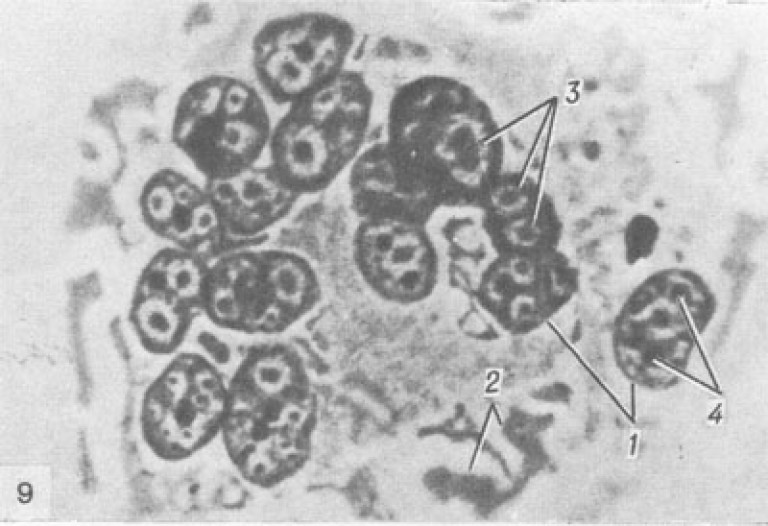
Rice. 3. The photo shows giant multinucleated Warthin-Finkelday cells.
Origin of measles rash
Allergic reactions develop in the patient's body to the protein components of pathogens. The permeability of small vessels increases, their walls are damaged. In organs and tissues (usually the respiratory and digestive systems) in the mucous membranes, catarrhal-necrotic inflammation develops. The upper layers of the skin are affected, on which a papular rash first appears. Subsequently, the epidermal cells undergo necrosis, which is manifested by peeling.
In the oral cavity, the epithelium also undergoes necrotization. It becomes cloudy. Foci of necrosis become similar to small white dots (Belsky-Filatov-Koplik spots). They appear a day before skin rashes. The skin rash appears in stages, starting from the head and then gradually spreading to the entire body.

Rice. 4. In the photo, the symptoms of measles are Belsky-Filatov-Koplik spots.
Development of complications
Measles viruses in the patient’s body suppress both general and local immunity. Under their influence, the number of T-lymphocytes decreases. Anergy develops. Chronic diseases are getting worse. The addition of a secondary infection causes the development of catarrhal-necrotic inflammation in the upper respiratory tract, digestive system and skin.
Signs and symptoms of measles in children and adults
Periods of the disease
During classical measles, four periods are distinguished: catarrhal, period of rash, pigmentation and recovery. The average duration of the disease is about 10 days. Fluctuations range from 8 to 21 days. Each period lasts 3 days. The catarrhal period can extend up to 7 days.
Incubation period
The incubation period (the period from the moment of infection with viruses until the appearance of the first symptoms of the disease) for measles is about 10 days. Fluctuations range from 8 to 13 - 17 days.

Rice. 5. The photo shows the appearance of a measles rash.
Signs and symptoms of measles during the catarrhal period
The disease begins with the development of inflammation of the mucous membranes of the upper respiratory tract and the conjunctiva of the eyes. There is copious mucous discharge from the nose, hoarseness and a dry cough. Body temperature rises to 39 o C. Symptoms of intoxication appear: weakness, weakness, general malaise and loss of appetite.
The conjunctiva of the eyes becomes hyperemic, the eyelids swell, and purulent discharge appears from the eyes. There is a decrease in the number of lymphocytes in the blood (lymphopenia).
When a rash appears, catarrhal symptoms weaken and disappear completely after 1 - 2 days. In the oral cavity, against the background of a hyperemic, loose and rough mucous membrane, small (the size of a poppy seed) whitish spots with a red rim along the periphery appear. The rashes are called Belsky-Filatov spots — Koplika. They are usually located on the cheek mucosa in the area of the molars. Pink spots (measles enanthema) appear on the mucous membrane of the soft and hard palate.
By the end of the third day, there is a decrease in body temperature, but during the period of the appearance of measles rash it again rises significantly, and the symptoms of intoxication and damage to the upper respiratory tract intensify.

Rice. 6. In the photo, the symptoms of measles are Belsky-Filatov-Koplik spots on the mucous membrane of the cheeks and measles enanthema in the palate.
Measles rash
The measles rash looks like papules about 2 mm in size, surrounded by an irregularly shaped area of redness. In some places the rash merges and then their configuration is similar to complex figures with wavy (scalloped) edges. The basic background of the skin remains unchanged. Sometimes petechiae (hemorrhages) are observed against the background of a measles rash.
The patient's rash appears on the 4th - 5th day of the disease. Initially, it is localized on the face, neck and behind the ears. Within a day, the rash spreads to the entire torso and covers the upper arms. After another day, the skin of the legs and lower arms becomes covered with a rash, while the rash on the face begins to turn pale.
In severe cases of the disease, the rash is confluent in nature. It covers all skin, including the palms and soles. Numerous hemorrhages and even hemorrhages appear on the skin, the diameter of which exceeds 3 mm (echimosis, in everyday life - bruises). Hemorrhages also appear on the mucous membrane of the eyes and mouth. Puffiness of the face, eyelids, nose and upper lip, redness of the conjunctiva of the eyes, purulent discharge, and rhinorrhea are the main symptoms of measles during this period.
After 3-4 days, a period of fading of the rash begins. Body temperature decreases. Pigmentation appears at the site of the rash - brown spots.
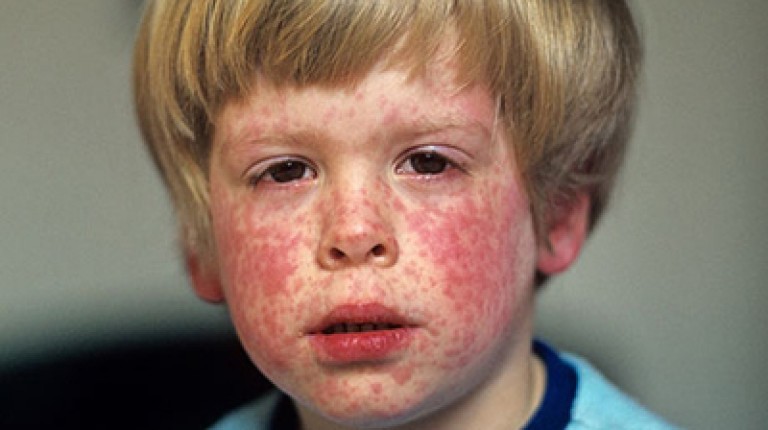
Rice. 7. The photo shows measles in a child, the initial stage. The rash at the beginning of the disease is localized on the face, neck and behind the ears (the first day of the rash).

Rice. 8. The photo shows measles in children. The rash appears on the torso and upper arms (second day of rash).

Rice. 9. In the photo, a child has measles. Measles rash, 2nd day of rash.
Signs and symptoms of measles in children and adults in the pigmentation stage
Pigmentation of the measles rash indicates that the patient has reached the end of the period of contagiousness and recovery.
Pigmentation of the rash, like rashes, occurs in stages. It is caused by the penetration of red blood cells into the skin during a rash and the subsequent breakdown of hemosiderin, a pigment that is formed as a result of the breakdown of hemoglobin.
The process begins on the 7th - 8th day of the disease and lasts up to 7 - 10 days. Pityriasis-like peeling is observed in areas of the rash. Body temperature gradually normalizes.
The general condition of the patient is returning to normal slowly. The phenomena of asthenia and immunosuppression persist for a long time.
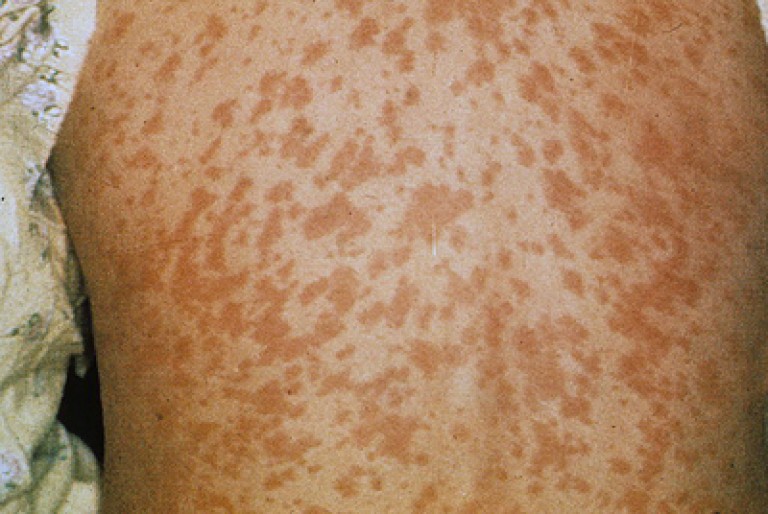
Rice. 10. The photo shows a measles rash in the pigmentation stage.
Signs and symptoms of measles in children of the first year of life
Measles in children of the first year of life has its own characteristics:
- catarrhal period is often absent,
- an increase in body temperature and the appearance of a rash occur simultaneously,
- bowel dysfunction is often observed,
- bacterial complications are recorded in 2/3 of children.
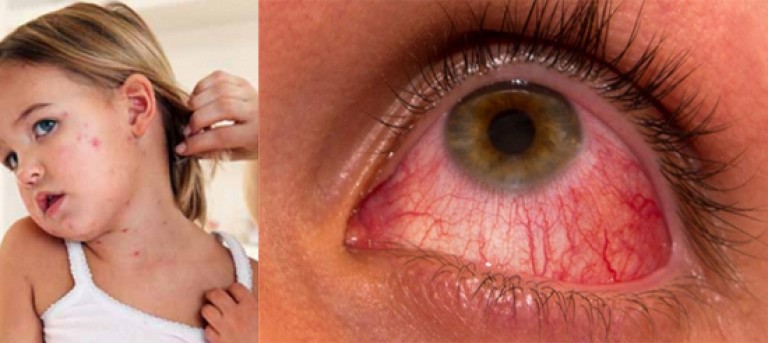
Rice. 11. The photo shows symptoms of measles: enlarged lymph nodes and conjunctivitis.
Complications (consequences) of measles
The cause of measles complications is the effect of the virus on the patient’s immune system. In the peripheral blood, the number of T-lymphocytes sharply decreases. Allergization of the body to the protein components of viruses contributes to the development of inflammation, which leads to increased permeability of small vessels and damage to their walls. In the mucous membranes of organs and tissues (usually the respiratory and digestive systems), catarrhal-necrotic inflammation develops.
- The layering of a secondary (viral-bacterial) infection leads to the development of a number of purulent-necrotic inflammatory processes in the nose, larynx, trachea, bronchi and lung tissue.
- Stomatitis and colitis develop.
- With the disease, conjunctivitis always develops. The cornea of the eye is often affected.
- During the period of pigmentation, inflammation of the middle ear often occurs.
- Under unfavorable sanitary and hygienic conditions, pustular lesions of the skin caused by streptococci and staphylococci develop.
- Microcirculation disorders in the brain lead to hypoxia and encephalopathy develops. Measles encephalopathy is more often recorded in young children. More severe complications of measles are encephalitis and meningoencephalitis. Pathology develops on days 5–7 of the disease. The course of the disease is severe, with a high mortality rate (up to 10%). Surviving children (about 40%) often have mental disorders and epilepsy.
- Damage to the optic and auditory nerves always results in serious consequences. Damage to the spinal cord leads to pelvic disorders.
- Very rarely, myocarditis, hepatitis and glomerulonephritis develop as a result of measles infection.
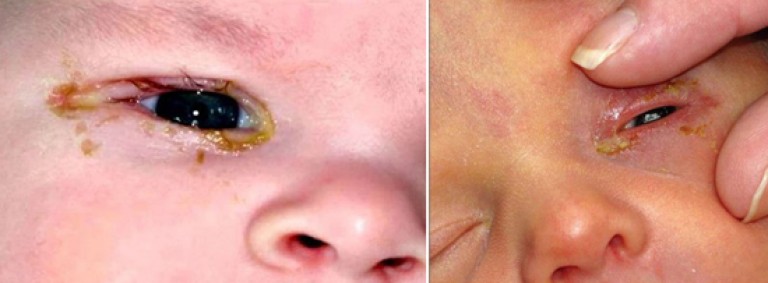
Rice. 12. The photo shows measles in children. The addition of a secondary infection leads to the development of bacterial conjunctivitis. The conjunctiva of the eyes becomes hyperemic, the eyelids swell, and purulent discharge appears from the eyes.
Atypical forms of measles
In addition to the typical course, the disease may have an atypical course.
Atypical (erased) form
An atypical form of measles is observed in children 3–9 months old, since during this period the disease develops against the background of passive immunity, which they receive at birth from their mother. The incubation period for the atypical course is extended, there are no typical signs of the disease, the course is blurred, and the phasing of the rash is disrupted.
Measles in vaccinated children
If for some reason a vaccinated child does not have antibodies against the disease, then when infected with measles viruses, the disease will proceed normally. If a small amount of antibodies remains in the child’s body, then measles will occur in an erased form.
Mitigated measles
Mitigated measles develops when a measles vaccine or immunoglobulin is administered to a person infected with measles viruses during the incubation period. A situation arises when an infected person has acquired immunity to the disease, but its level is insufficient. The developed disease occurs in a mild form.
- The incubation period for mitigated measles is extended and ranges from 21 to 28 days.
- The catarrhal period is short and ends after 1 - 2 days, or is completely absent.
- Symptoms of the disease are mild.
- Body temperature is often absent or rises to low-grade levels. There are no Belsky-Filatov-Koplik spots on the buccal mucosa.
- The rash on the skin is scanty, not abundant, pale in color. It appears simultaneously on all areas of the skin and is often absent on the extremities. Not inclined to merge. The pigmentation of the rash is weak and disappears quickly.
- The disease proceeds without complications.
- Diagnosis of the disease is often difficult. The basis of laboratory diagnosis is serological testing.
"Black" or hemorrhagic measles
In severe cases of the disease, the rash may become hemorrhagic. Numerous hemorrhages and even hemorrhages appear on the skin, the diameter of which exceeds 3 mm (echimosis, in everyday life - bruises). Hemorrhages also appear on the mucous membrane of the eyes and mouth.
Congestive (dyspnoic) form of measles
The congestive or dyspnoic form of the disease is manifested by severe shortness of breath and continuous cough, with scant physical data. The rash appears late and has a cyanotic tint. Hypoxia gradually increases. Lack of blood circulation in the brain leads to seizures and loss of consciousness. The cause of the congestive or dyspnoic form of measles is considered to be damage to lung tissue by viruses (pulmonary measles).
Reaction to vaccination
When administered a live measles vaccine, 25–50% of children develop a severe reaction resembling mitigated measles. This reaction occurs with elevated body temperature, catarrh of the upper respiratory tract and scant rash. Convulsions and vomiting are rarely observed.
Vaccinated individuals do not pose a danger to others. Children with immunodeficiencies are not allowed to receive vaccinations. The introduction of a live vaccine causes a severe reaction in them.
Course of measles in persons with immunodeficiency
In 80% of cases in people with immunodeficiency, the disease is extremely severe. In 70% of cases in cancer patients and in 40% of cases in HIV-infected people, measles is fatal. In a third of patients with immunodeficiency, there is no rash due to measles; in 60% of cases, the rash is atypical. The complications are severe.
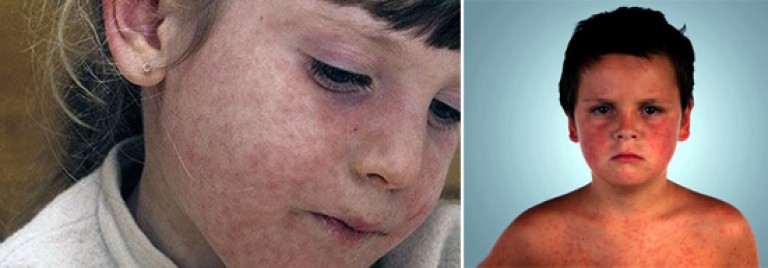
Rice. 13. Figures 22 and 23. The photo shows measles in children. In the photo on the left there is a rash on the face (day 1 of the rash), in the photo on the right there is a rash on the face and torso (day 2 of the rash).
Measles in adults
Measles in adults and adolescents is often severe. The intoxication syndrome is significantly expressed. Patients often experience severe headaches and vomiting. Sleep is disturbed. The catarrhal period lasts 4 - 8 days. Catarrhal symptoms of the upper respiratory tract are weakly expressed, Belsky-Filatov-Koplik spots are abundant, often persisting throughout the entire period of the rash. The rash is profuse. Several groups of lymph nodes are enlarged. Sometimes an enlarged spleen is palpable. Complications rarely develop.

Rice. 14. The photo shows measles in adults. A rash is the main symptom of the disease.
Prognosis for measles
The prognosis for uncomplicated disease is favorable. The mortality rate for measles is no more than 1.5%. It mainly occurs in children in the first year of life.
Immunity against measles
After measles, a strong immunity usually develops. Cases of recurrent disease are extremely rare. After vaccination, immunity weakens over the years and after 10 years only 1/3 of those vaccinated retain it.
Among infectious diseases of various etiologies, measles during the incubation period can manifest itself as a cold. Measles is actually spreading among children preschool age. But this is by no means just a childhood “sore”. Adults can also get measles. Unlike children, the course of the disease in adults is difficult to tolerate. If for children the disease does not cause any complications, then in adults the course of the disease can be complicated by diseases of the respiratory system. not just complications. In severe cases, it cannot be treated and the person dies. Oddly enough, the WHO recorded outbreaks of the disease in African countries in 2000. As a result of the epidemic, up to 1.5 million people died. Therefore, one should not take this infectious disease lightly.
Nature of the disease
Measles, as an acute infectious disease, affects the mucous membranes of the respiratory tract and eyes. Later, rashes appear and the patient feels weak. The disease is caused by a virus that develops inside cell membranes. IN environment the virus loses its properties, does not reproduce in a dry environment and dies under the influence of ultraviolet rays
 The disease is transmitted by airborne droplets. You can become infected from another person. Having had measles once, a person develops antibodies, and re-infection is impossible. When caring for a patient, those around them should remember that the risk of contracting measles exists during the incubation period. When the disease becomes more complicated and pneumonia develops, the risk of infection is very high. The infection is not transmitted through objects or food. Due to the fact that they die in the environment, a sufficient preventive measure would be to ventilate the room. Severe measles is observed in children with insufficient physical development, blood diseases, diathesis and rickets.
The disease is transmitted by airborne droplets. You can become infected from another person. Having had measles once, a person develops antibodies, and re-infection is impossible. When caring for a patient, those around them should remember that the risk of contracting measles exists during the incubation period. When the disease becomes more complicated and pneumonia develops, the risk of infection is very high. The infection is not transmitted through objects or food. Due to the fact that they die in the environment, a sufficient preventive measure would be to ventilate the room. Severe measles is observed in children with insufficient physical development, blood diseases, diathesis and rickets.
For children under six months of age, the disease is not dangerous. But if a pregnant woman is infected with measles before giving birth, then the likelihood of her newborn baby getting sick is very high. In general, after nine months a newborn can become infected with measles, since at this time the body is susceptible to the virus. Medical statistics state the optimal age for infection is 5 years. The disease almost never occurs.
Mechanism of disease
The virus enters the blood through the upper respiratory tract and provokes inflammation of the pharynx, larynx, and stomach. Rashes appear on the skin. The immune system weakens and this creates conditions for the resumption of chronic diseases. Due to changes in the morphological structure of cells, there is a risk of pneumonia. The lesion can expand its localization and affect the tissues of the trachea and bronchi.
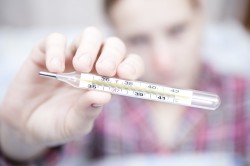 There are two forms of measles disease: typical and atypical. The latter is easier to tolerate by patients. In the atypical form, the incubation period lasts 21 days. The course of the disease is not complicated by high fever and runny nose. There is almost no rash on the body and on the mucous membranes of the mouth. The atypical form manifests itself in abortive and erased forms. Symptoms of the abortive type are:
There are two forms of measles disease: typical and atypical. The latter is easier to tolerate by patients. In the atypical form, the incubation period lasts 21 days. The course of the disease is not complicated by high fever and runny nose. There is almost no rash on the body and on the mucous membranes of the mouth. The atypical form manifests itself in abortive and erased forms. Symptoms of the abortive type are:
- high temperature in the first 4 days;
- a small pink rash that is localized on the face and upper back;
- yellow pigmentation;
- recovery occurs on day 6.
In the erased form, the disease lasts 4-5 days, there is no rash, and a low temperature is observed. This form is diagnosed using tests.
In the typical form, complications appear.
Clinical picture of severe measles
 In the incubation period of measles (1-2 weeks, in a complicated form up to 4 weeks) there are three stages:
In the incubation period of measles (1-2 weeks, in a complicated form up to 4 weeks) there are three stages:
- Catarrhal.
- Rash.
- Pigmentation.
The onset of the catarrhal stage begins with general malaise and fever. Against the background of a headache, appetite decreases and dynamics are disrupted. In adults, this period is more difficult than in children. A runny nose is accompanied by copious mucous discharge, and a dry cough appears. Hoarseness of voice. The mucous membrane of the eye becomes inflamed and becomes red, accompanied by conjunctivitis. Bright light causes pain in the patient's eyes.
In children at this stage of the disease, redness of the throat and mouth is observed. In adults, this symptom rarely occurs, but swollen lymph nodes and mushy stools are present.
Three days later, the patient’s clinical condition improves and the temperature decreases. But on the fourth day, measles worsens and the temperature rises. Then you can find peculiar spots in the oral mucosa in the form of “semolina scattered on a red background.” After two days they turn red. The catarrhal period lasts up to 5 days in children and up to 8 days in adults.
At the rash stage, bright red spots merge and spread to healthy areas of the skin. The rash first appears on the scalp, face and neck. Then it appears on the back and arms. Subsequently, the red rash spreads to the legs. Children have less rash than adults. At this stage, the cough and runny nose become intense. In adults, blood pressure and tachycardia may increase.
The pigmentation stage is characterized by a satisfactory condition, body temperature decreases, and problems with a runny nose are eliminated. The rashes change color and become light brown. Pigmentation completely disappears within 8 days. At the site of the rash, the skin becomes rough and rough.
Diagnosis and treatment of the disease
In terms of its symptoms in the first three days, the disease is not much different from an acute viral disease. Only after the rash can measles be diagnosed. But even at this stage there is a possibility of error. similar to the rash of scarlet fever. To differentiate the disease, a serological test is performed. Additional symptoms of measles are hyperemia of the mucous membranes of the mouth and eyes.
Antibiotics in mild form are almost never used. But for concomitant diseases, antibiotics are used. For mild forms of measles, antiviral and antimicrobial drugs are used that eliminate pathogenic microflora and restore the body. Vitamins A and C are used to prevent the disease. Modern medicine widely uses vaccination to prevent measles. Correct vaccination, which was carried out in accordance with the calendar dates of vaccinations, can reduce the risk of the disease, and in case of infection, it will significantly reduce the course of the disease.
Unfavorable outcome of the disease
Unfortunately, the disease can lead to dire consequences. A common disease that appears in the medical history is pneumonia. Laryngitis is an equally insidious disease against the background of measles. It appears at the initial stage of the incubation period. Cough and hoarseness disappear until the end of recovery. With late onset of laryngitis, at the rash stage, the disease requires long-term treatment. If breathing is difficult, surgery may be indicated.
In children, there are still rare cases of complications of coryencephalitis. IN recent years decreased, and for adults these indicators became increased. This is explained by the fact that they have not developed immunity to this strain of viruses, and natural protective “agents” are not produced, because you were not sick as a child. Be careful and watch your health!
One of the “childhood” infectious diseases is measles. Characteristic Features The disease is considered to be highly contagious, with the appearance of a rash that is localized on the face, neck and hands. The disease is accompanied by other unpleasant symptoms, the only way to get rid of them is complex treatment, which should be prescribed exclusively by a doctor after a thorough examination of the patient and an accurate diagnosis. Despite the fact that the disease is considered “childhood”, sometimes it also occurs in representatives of the older generation and most often these are people who did not have measles in childhood and do not have immunity to the disease. Compliance with preventive measures, as well as vaccination, will help prevent the development of the disease.
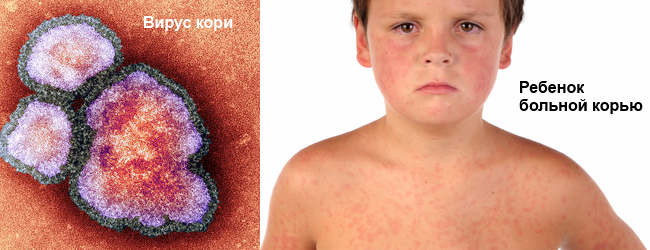
What is measles?
Measles is a childhood infectious disease transmitted by airborne droplets and manifested by a number of unpleasant symptoms. The source of infection is a sick person who is dangerous to others from the incubation period (the last 3 days) until the fourth day from the moment the rash appears. Infection can occur when a patient coughs or sneezes, because the maximum concentration of the virus is observed in sputum and mucus.
Measles infection primarily affects the mucous membranes of the respiratory and oral organs, the skin (the appearance of a rash) and the eyes (development, inflammation of the eyelids). Often the disease leads to general intoxication of the body.
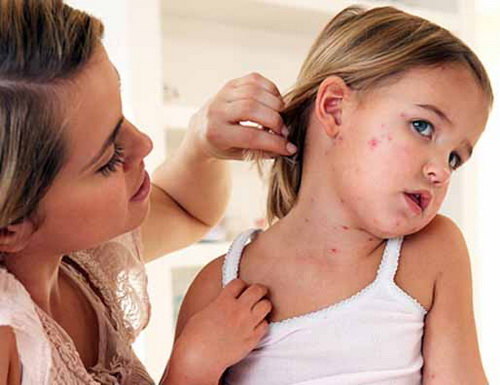
Once the infection enters the body, it remains dormant for some time and does not manifest itself in any way. The incubation period for measles can last from 8 to 14 days (in some cases this period can be up to 17 days). 
Young children from two to five years of age are more susceptible to the disease; adults become infected with the disease extremely rarely, only if they did not have measles in childhood. After birth and the first few months, babies experience colostral immunity, which is transmitted to them from their mother if she suffered from the disease in childhood. Most often, patients are diagnosed with measles in winter or early spring.
Children who have had measles develop a strong immunity to the infection, so it is impossible to get it again. The exception is pathological changes in the immune system or its complete destruction.
The course of the disease is characterized by three stages, which are characterized by symptoms and differ in clinical picture:
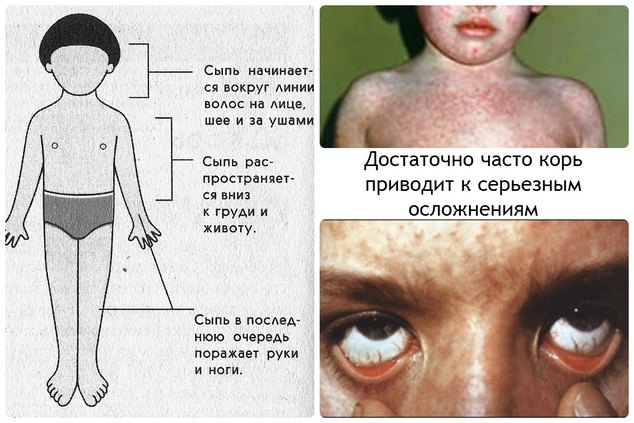
Reasons for the development of the disease
The main reason for contracting measles is the lack of immunity to the infection. You can get it in several ways: having already had the disease or getting vaccinated.
The main prerequisites for the development of the disease include:
- Lack of immunity and vaccinations.
- Close contact with a person with measles.
- General weakening of the body and immune system.
Symptoms of the disease
Measles has a number of characteristic symptoms that help distinguish it from other diseases. During the incubation period, there are no signs, but a person can already be contagious and spread the infection among his environment without even knowing it. With the onset of the disease, signs appear that are often similar to those of a classic viral infection.
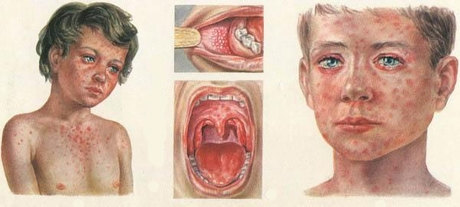
The main symptoms of measles include:
- An increase in body temperature, often the thermometer reaches 40 degrees.
- Dry cough, hoarseness of voice.
- The appearance of photophobia, swelling of the eyelids and redness of the eyeball. Conjunctivitis is very common.
- The appearance of white spots on the mucous membrane of the gums and cheeks.
- White coating on the tongue and tonsils.
- The appearance of a rash all over the body, quickly changing its pigmentation. The rash appears from above (head, neck), after which it affects the body, arms and only then goes down to the knees and feet.
Diagnosis of the disease
At the first stages, measles is very similar to a viral disease, and with the appearance of a rash, many people confuse it with other infectious diseases (,), so it is extremely important to distinguish between the disease and make a correct diagnosis. For diagnosis, you should call a doctor at home (you should not visit a medical facility, since the disease is contagious or only using a mask), and during the initial examination, after reading the complaints and obvious symptoms, the doctor determines the nature of the disease.

In order to assess the general condition of the patient and confirm the diagnosis, a number of laboratory tests and other studies may be prescribed:
- . With the development of an infectious disease, an increased ESR, plasmacytosis and lymphocytosis are observed in the patient’s blood.
- Taking a swab from the throat.
- (the presence of protein and a high level of leukocytes indicate the inflammatory process).
- Carrying out an X-ray of the lungs if there is a suspicion of the development of pneumonia.
- In case of damage to the nervous system, it can be carried out with subsequent consultation with a neurologist.
Treatment of measles
After diagnosing and making an accurate diagnosis, the doctor prescribes treatment, taking into account the following factors: the patient’s age, the general condition and well-being of the patient, the severity of the disease and the presence of complications. In 98% of cases, a person with measles is treated at home. In case of a severe form of the disease, the development of complications or the presence of other individual factors, the patient is placed in a hospital in the infectious diseases department.
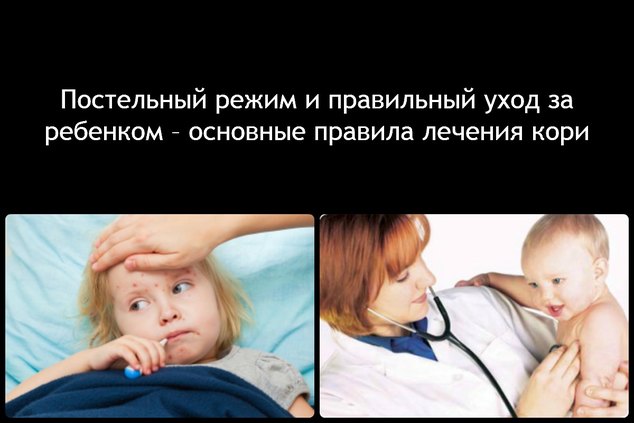
In order for therapeutic therapy to have maximum effect, it is necessary to strictly observe bed rest. It is extremely difficult to achieve this from children, but suffering the disease “on your feet” is extremely dangerous, since this can provoke the development of a number of complications. In addition, another important point is to isolate the patient from others, in particular people who do not have vaccinations or immunity to the disease.

One of the symptoms of the disease is photophobia, so it is extremely important to place the child in a room where there is no bright sunlight and where it is possible to turn on a dim lamp. It is extremely important to ensure normal temperature air and humidity - this will help the patient breathe easier and will not allow the mucous membranes of the respiratory organs, which are already sufficiently damaged, to dry out. 
Particular attention should be paid to the nutrition of a child with measles: food should be of moderate temperature (neither hot nor cold), soft in consistency, so that swallowing does not cause discomfort.
You should absolutely not eat spicy, smoked, salty foods - the abundance of seasonings irritates the mucous membranes, causes pain, discomfort, as a result of which the child may completely refuse to eat.
Do not forget about maintaining a drinking regime - the child must drink a large amount of liquid, firstly, due to the high temperature, in order to avoid dehydration, and secondly, to quickly remove toxins and intoxication products from the body. Drinking should not only be plentiful, but also of high quality - preference should be given to clean filtered or mineral water without gases, but it is better to avoid juices, sweet compotes or carbonated drinks.
Not in medicine medicinal product, which is aimed at fighting measles, therefore a number of medications are used that are aimed at eliminating symptoms:
- Drugs emergency prevention upon contact with a patient with measles - aimed at creating immune protection against infection. For example, “Leuinferon” (one injection for 5 days), anti-measles U-globulin (administered once).
- Antihistamines to prevent the development of an allergic reaction: Diazolin or Suprastin (1 tablet three times a day); Loratadine (one per day).
- Medicines that normalize body temperature: Paracetamol, Efferalgan, Panadol (1 tablet 2-4 times a day, depending on the child’s condition); “Nurofen” or “Ibuprofen” - the dosage depends on the weight and age of the child.
- Vitamins to strengthen the general condition of the patient.
- Antibacterial therapy is prescribed if measles is accompanied by a bacterial infection. The medications used are: Clarithromycin (administered intravenously through a dropper - 500 mg twice a day) or Sumamed (1 tablet (500 mg) once a day).

Traditional medicine methods are often used to alleviate the patient’s condition:
- Raspberry tea. Pour boiling water over one spoonful of dried raspberries and leave to steep for 30 minutes. Drink 150 ml three times a day. This simple, tasty and aromatic remedy will help normalize your temperature and improve your overall well-being.
- Violet tincture. Place 2 spoons of flowers in a thermos and pour 400 ml of boiling water over them. Leave for at least 1.5 hours, strain. Drink in small portions throughout the day on an empty stomach. This drink helps prevent the spread of the rash throughout the body, reduces the temperature and cleanses the blood of the virus.
- Linden decoction. Pour 200 ml of boiling water over linden flowers (1 tablespoon) and heat in a water bath. Drink 0.5 cups in the morning and evening before meals. This decoction helps remove intoxication, cough, and also helps normalize the temperature.
- Viburnum tea. Pour boiling water over dried viburnum berries and leave in a thermos. Take 4 tablespoons 3 times a day, while retaining the liquid in your mouth - this will help remove inflammatory process on mucous membranes.
Preventing measles
General preventive measures for measles include:
- Conducting vaccinations. Everyone is vaccinated against measles in childhood.
- Strengthening the immune system (taking multivitamins, a balanced nutritious diet, regular walks in the fresh air, hardening).
- Avoiding contact with a sick person.
- Regular ventilation of the room where the patient lies, quartz treatment.
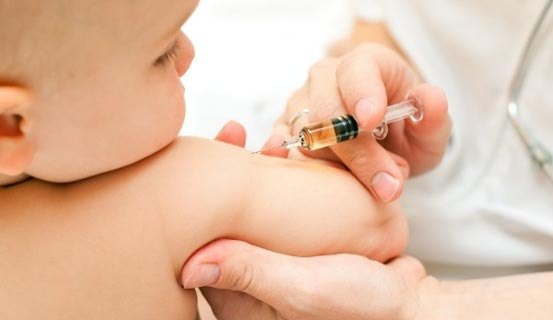
- What is Measles
- What causes measles
- Measles symptoms
- Diagnosis of Measles
- Treatment of Measles
- Prevention of Measles
- Which doctors should you contact if you have Measles?
What is Measles
Measles (lat. Morbilli)- an acute infectious viral disease with a high level of susceptibility (the contagiousness index approaches 100%), which is characterized by high fever (up to 40.5 °C), inflammation of the mucous membranes of the oral cavity and upper respiratory tract, conjunctivitis and a characteristic maculopapular rash of the skin , general intoxication.Measles has been known since ancient times. Its detailed clinical description was compiled by the Arab physician Rhazes (IX century), and the Englishmen T. Sidnam and R. Morton (XVII century). Since the 18th century, measles has been considered as an independent nosology. The viral etiology of the disease was proven by A. Anderson and D. Goldberger (1911). The pathogen was isolated by D. Enders and T.K. Peebles (1954). Effective seroprophylaxis of measles was developed by R. Degkwitz (1916-1920). The live vaccine, used since 1967 for routine vaccination, was developed by A.A. Smorodintsev et al. (1960).
What causes measles
The causative agent of measles is an RNA virus of the genus Morbillivirus, family of Paramyxoviruses, has a spherical shape and a diameter of 120-230 nm. It consists of a nucleocapsid - an RNA helix plus three proteins and an outer shell formed by matrix proteins (surface glucoproteins) of two types - one of them is hemagglutinin, the other is a “dumbbell-shaped” protein.
All known strains of the virus belong to the same serovar; the antigenic structure is similar to the pathogens of parainfluenza and mumps. The most important antigens are hemagglutinin, hemolysin, nucleocapsid and membrane protein.
The virus is not stable in the external environment and quickly dies outside the human body from exposure to various chemical and physical factors (irradiation, boiling, treatment with disinfectants). At room temperature it remains active for about 1-2 days, at low temperatures for several weeks. The optimal temperature for preserving the virus is (-15)-(-20) °C.
Despite its instability to the external environment, there are known cases of the virus spreading over significant distances with the flow of air through the ventilation system - during the cold season in one single building. Weakened strains of measles virus are used to produce live measles vaccine.
Pathogenesis (what happens?) during Measles
Measles transmission route- airborne, the virus is released into the external environment in large quantities by a sick person with mucus during coughing, sneezing, etc.
Source of infection- a patient with measles in any form who is contagious to others with last days incubation period (last 2 days) until the 4th day of rash. From the 5th day of the rash, the patient is considered non-infectious.
Measles affects mainly children aged 2-5 years and much less often adults who did not have this disease in childhood. Newborn children have colostral immunity, passed on to them from their mothers if they have previously had measles. This immunity lasts for the first 3 months of life. There are cases of congenital measles due to transplacental infection of the fetus with the virus from a sick mother.
After an illness, stable immunity develops; re-infection with measles in humans, without concomitant pathology of the immune system, is doubtful, although such cases have been described. Most cases of measles are observed in the winter-spring (December-May) period, with an increase in incidence every 2-4 years.
Currently, in countries that carry out total measles vaccination, the disease occurs in the form of isolated cases or mini-epidemics.
The gates of infection are the mucous membranes of the upper respiratory tract and, possibly, the conjunctiva. After primary replication in epithelial cells and regional lymph nodes, the pathogen enters the blood, and primary viremia develops already in the incubation period. As a result, the virus disseminates, becomes fixed in various organs and accumulates secondarily in the cells of the macrophage system. In organs (lymph nodes, tonsils, lungs, intestines, liver and spleen, myeloid tissue of bone marrow), small inflammatory infiltrates develop with proliferation of the reticuloendothelium and the formation of multinucleated giant cells. During the incubation period, the number of viruses in the body is still relatively small and can be neutralized by administering measles immunoglobulin to persons who have been in contact with a measles patient no later than the 5th day after contact.
The appearance of catarrhal symptoms of the disease coincides with the occurrence of a second wave of viremia. The maximum concentration of the virus in the blood persists throughout the catarrhal period and the first day of the rash, then drops sharply. By the 5th day of the rash, virus-neutralizing antibodies appear in the blood, but the virus is no longer detectable.
Having a tropism for epithelial cells of the mucous membranes and the central nervous system, the virus mainly affects the upper respiratory tract (sometimes also the bronchi and lungs), the conjunctiva, and to a small extent the gastrointestinal tract. Inflammation develops with the appearance of giant cells in the lymphoid formations of the intestine, as well as in the central nervous system, resulting in the possibility of developing complications in the form of meningitis and meningoencephalitis. The protein components of the virus and biologically active substances released in response to the circulation of the virus give catarrhal inflammation in the affected organs an infectious-allergic character. A specific inflammatory focal process with an allergic reaction, epithelial degeneration, increased vascular permeability, perivascular infiltration and edema underlies the formation of measles enanthema, Filatov-Koplik-Velsky spots on the mucous membrane of the cheeks and lips, and later exanthema.
Systemic damage to lymphoid tissue, macrophage elements, parts of the central nervous system (reticular formation, subtubercular region, etc.) leads to transient suppression of humoral and cellular immune reactions. The weakening of the activity of nonspecific and specific protective factors characteristic of measles, extensive damage to the mucous membranes of the respiratory tract and gastrointestinal tract, as well as a decrease in vitamin metabolism with a deficiency of vitamins C and A constitute a group of factors that contribute to the occurrence of various bacterial complications.
After recovery, immunity is formed with lifelong preservation of anti-measles antibodies in the blood. At the same time, it is believed that the virus can remain in the human body for a long time and be responsible for the development of a slow infection in the form of multiple sclerosis, subacute sclerosing panencephalitis, and also, possibly, some systemic diseases - systemic lupus erythematosus, systemic scleroderma, rheumatoid arthritis.
Microscopic picture: mucous membrane of the respiratory tract - edema, congestion of blood vessels, foci of necrosis, areas of epithelial metaplasia, focal lymphohistiocytic infiltration in the submucosal layer. Reticuloendothelial system - Warthin-Finkeldey cells. Skin - changes in the papillary layer of the dermis in the form of edema, congestion of blood vessels, hemorrhages with perivascular lymphohistiocytic infiltration, foci of necrosis in the epidermis.
Measles symptoms
Incubation period averages 1-2 weeks; with passive immunization with immunoglobulin, it can extend to 3-4 weeks. Existing clinical classifications distinguish the typical form of measles of varying degrees of severity and the atypical form. The cyclical nature of the disease in its typical form allows us to distinguish three successive periods of clinical manifestations of measles:
• catarrhal period;
• period of rash;
• period of convalescence.
Catarrhal period begins sharply. General malaise, headache, loss of appetite, and sleep disturbances appear. Body temperature rises, in severe forms it reaches 39-40 °C. Signs of intoxication in adult patients are much more pronounced than in children. From the first days of illness, a runny nose with copious mucous, sometimes mucopurulent, discharge is noted. An obsessive dry cough develops; in children it often becomes rough, “barking”, accompanied by hoarseness and (in some cases) stenotic breathing. At the same time, conjunctivitis develops with swelling of the eyelids, conjunctival hyperemia, scleral injection and purulent discharge. Often in the morning the eyelids stick together. The patient is irritated by bright light. When examining children with measles, puffiness of the face, hyperemia of the mucous membrane of the oropharynx, and granularity of the posterior pharyngeal wall are revealed. In adults, these symptoms are mild, but lymphadenopathy is observed (mainly in the cervical lymph nodes), harsh breathing and dry wheezing in the lungs are heard. Some patients experience short-term, pasty stools.
On the 3-5th day, the patient’s well-being improves somewhat, and the fever decreases. However, after a day, the manifestations of intoxication and catarrhal syndrome intensify again, and the body temperature rises to high numbers. At this moment, on the mucous membrane of the cheeks opposite the small molars (less often on the mucous membrane of the lips and gums), one can detect a cardinal clinical diagnostic sign of measles - Filatov-Koplik-Velsky spots. They are slightly protruding and tightly fixed white spots, surrounded by a thin border of hyperemia (a type of “semolina porridge”). In children, the elements usually disappear with the appearance of exanthema; in adults they can persist during its first days. Somewhat earlier than Filatov-Koplik-Velsky spots or simultaneously with them, measles enanthema appears on the mucous membrane of the soft and partially hard palate in the form of red spots of irregular shape, the size of a pinhead. After 1-2 days they merge and are lost against the general hyperemic background of the mucous membrane.
At the same time, with an increase in intoxication symptoms, dyspeptic symptoms can sometimes be observed. In general, the catarrhal period lasts 3-5 days, in adults it sometimes lasts up to 6-8 days.
Rash period replaces the catarrhal period. Characteristic is the appearance of a bright maculopapular exanthema, which tends to merge and form figures with areas of healthy skin between them.
• On the first day, elements of the rash appear behind the ears, on the scalp, then on the same day they appear on the face and neck, upper chest.
• On the 2nd day of the rash, the rash covers the torso and upper arms.
• On the 3rd day, elements of exanthema appear on lower limbs and distal parts of the arms, and the face turns pale.
Descending sequence of rashes is characteristic of measles and serves as a very important differential diagnostic sign. In adults, the rash is more abundant than in children; it is large macular-papular, often confluent; with a more severe course of the disease, hemorrhagic elements may appear.
The period of rash is accompanied by an increase in catarrhal symptoms - runny nose, cough, lacrimation, photophobia - and the maximum severity of fever and other signs of toxicosis. When examining patients, signs of tracheobronchitis, moderate tachycardia and arterial hypotension are often revealed.
Convalescence period(pigmentation period) is manifested by an improvement in the general condition of patients: their health becomes satisfactory, body temperature normalizes, and catarrhal symptoms gradually disappear. The elements of the rash turn pale and fade away in the same order in which they appeared, gradually turning into light brown spots. Subsequently, the pigmentation disappears in 5-7 days. After its disappearance, pityriasis-like peeling of the skin can be observed, mainly on the face. Pigmentation and peeling are also diagnostic, although retrospective, signs of measles.
During this period, a decrease in the activity of nonspecific and specific protective factors (measles anergy) is noted. The body's reactivity is restored slowly; over the next few weeks and even months, reduced resistance to various pathogenic agents remains.
Mitigated measles. An atypical form that develops in individuals who have received passive or active immunization against measles or who have previously had it. It is distinguished by a longer incubation period, a mild course with little or no pronounced intoxication, and a shortened catarrhal period. Filatov-Koplik-Velsky spots are most often absent. The rash is typical, but the rash may occur simultaneously over the entire surface of the torso and limbs or have an ascending sequence.
Abortion measles also refers to atypical forms of the disease. It begins as a typical form, but is interrupted after 1-2 days from the onset of the disease. The rash appears only on the face and torso; an increase in body temperature is usually observed only on the first day of the rash.
Also meet subclinical variants of measles, detected only by serological testing of paired blood sera.
Complications of measles
The most common complication of measles is pneumonia. Laryngitis and laryngotracheobronchitis in young children can lead to the development of false croup. Stomatitis occurs. Meningitis, meningoencephalitis and polyneuritis are more often observed in adults; these conditions usually develop during the period of pigmentation. The most serious, but fortunately rare complication (more often in adults) is measles encephalitis.
Diagnosis of Measles
Laboratory data for measles:
lymphopenia, leukopenia, in case of bacterial complications - leukocytosis, neutrophilia. With measles encephalitis, there is an increased content of lymphocytes in the cerebrospinal fluid. 1-2 days after the rash, specific IgM increases. After 10 days IgG. To identify specific anti-measles antibodies, the hemagglutination reaction is used. IN early dates The virus is detected by immunofluorescence.
Isolation of the virus from nasopharyngeal swabs and the performance of serological tests (RTGA, RSK and RN in paired sera) are rarely used in clinical practice, since their results are retrospective.
Measles should be differentiated from rubella, scarlet fever, pseudotuberculosis, allergic (drug-induced, etc.) dermatitis, enterovirus infections, serum sickness and other diseases accompanied by the appearance of skin rashes.
Measles is distinguished by a complex of main clinical manifestations in the catarrhal period: intoxication, runny nose with copious discharge, obsessive rough, “barking” cough, hoarseness of voice, severe conjunctivitis with swelling of the eyelids, injection of scleral vessels and purulent discharge, photophobia, the appearance of a cardinal clinical diagnostic sign - Filatov’s spots -Koplik-Velsky on the 3-5th day of illness. Then a bright maculopapular exanthema appears, which tends to merge. A very important differential diagnostic feature characteristic of measles (with the exception of mitigated measles) is the descending sequence of rashes.
Treatment of Measles
Treatment of measles symptomatic, in case of development of pneumonia or other bacterial complications, antibiotics are indicated; in severe cases of croup, corticosteroids are used. Ribavirin has shown its effectiveness in vitro. Large doses of vitamin A can be used for prevention and treatment.
Uncomplicated forms are often treated at home. Patients with severe and complicated forms are hospitalized, as well as for epidemiological indications. The duration of bed rest depends on the degree of intoxication and its duration. No special diet required. Causal therapy has not been developed. Intoxication is combated by administering large amounts of fluid. Carry out oral and eye care. Eliminate the irritating effects of direct sunlight and bright artificial light. Antihistamines and symptomatic drugs are also prescribed. There are reports of the positive effect of interferon (leukinferon) when prescribed in the early stages of the disease to adult patients. In some cases, with severe and complicated measles, antibiotics may be prescribed. For measles encephalitis, it is necessary to use large doses of prednisolone under the guise of antibacterial drugs.
Prevention of Measles
Total two-time vaccination of children with measles vaccine at the ages of 1 year and 6 years. The measles vaccine was first created in 1966.
For active immunoprophylaxis of measles, live measles vaccine (LMV) is used. It is prepared from the vaccine strain L-16, grown in cell culture of Japanese quail embryos. In Ukraine, the use of the LIV Ruvax (Aventis-Pasteur, France), a complex vaccine against measles, rubella and mumps MMR (Merck Sharp Dome, USA) is authorized.
Live measles vaccine is administered to children who have not had measles from 12-15 months of age. Revaccination is carried out in the same way as vaccination, once at 6 years of age, before entering school. Its goal is to protect children who, for one reason or another, have not developed immunity. Immunization of at least 95% of children provides a good protective effect. To monitor the state of immunity of the population, random serological studies are carried out. The WHO Regional Committee for Europe, at its 48th session (1998), adopted the Health 21 program as targets for eliminating measles from the Region by 2007 or earlier. By 2010, disease elimination must be registered and certified in every country.
Specialists from the Pavlov First Medical University in St. Petersburg have created nanoparticles that can be used to diagnose infarction and pre-infarction conditions in a patient. Also, in the future of research, nanoparticles will be used...
Medical articles
Viruses not only float in the air, but can also land on handrails, seats and other surfaces, while remaining active. Therefore, when traveling or in public places, it is advisable not only to exclude communication with other people, but also to avoid...
Regaining good vision and saying goodbye to glasses and contact lenses forever is the dream of many people. Now it can be made a reality quickly and safely. The completely non-contact Femto-LASIK technique opens up new possibilities for laser vision correction.
Cosmetics designed to care for our skin and hair may actually not be as safe as we think
Lactostasis is a condition caused by a delay breast milk in the gland and its ducts. Every woman in the postpartum period experiences one degree or another of lactostasis, especially if it was her first birth.
Measles is a viral infection caused by the measles virus.
Causes of measles infection
The virus is transmitted only from a sick person to a healthy person through the air when sneezing and coughing. In the environment, the virus is unstable and dies quickly: when exposed to light in saliva, the virus dies within 5 minutes, when dried instantly. However, the virus can withstand low temperatures very well: when cooled to -70º C, it can remain alive for 5 years. Children aged 4-5 years are most often affected.
Symptoms of measles in children
During the disease, there are 4 periods: incubation, catarrhal period, rash period, pigmentation period.
Incubation period. Its duration is 17-21 days, the minimum is 9 days. This is the period from the moment the virus enters the child’s body until clinical signs appear. This period is asymptomatic, there are no manifestations. The virus, having entered the child’s body through the respiratory tract (nose, mouth) or eyes, begins to multiply in the cells of the mucous membrane of these organs. After a sufficient number of viruses accumulate in these tissues, they enter the blood, and the second period of the disease begins. A child with measles becomes infectious in the last 5 days of the incubation period.
Catarrhal period. The duration of the catarrhal period is 3-4 days. This period is characterized by the appearance of clinical symptoms: red eyes, photophobia, cough, runny nose, and increased body temperature. Children become lethargic, inactive, and drowsy. On the mucous membrane of the mouth, at the base of the molars, spots specific to measles appear - Belsky-Filatov-Koplik spots. These are areas of the mucosa in which epithelial cells are destroyed and gradually slough off. They look like small gray-whitish dots surrounded by an area of redness. These spots help to make an early correct diagnosis even before the rash appears and isolate the child from other children.
A feature of the catarrhal period is that all symptoms tend to increase (get worse). The cough becomes stronger, it is dry, often barking, as laryngotracheitis (inflammation of the larynx and trachea) develops. The temperature gradually increases and can reach 40º C. During the peak of clinical manifestations (highest temperature, frequent, dry cough), the first elements of the rash appear, and the next stage of the disease begins. The child is contagious throughout the entire period of catarrhal manifestations.
Period of rash. This period begins against the background of a maximum increase in temperature and frequent severe dry cough. Rashes begin to appear on the head: on the face and behind the ears. The rash consists of red-burgundy spots, which, when there are a large number of them, begin to merge with each other, forming large shapeless spots, sometimes rising above the level of the skin. The appearance of a sick child is characteristic: the face is puffy, the eyelids and nose are swollen, the lips are dry, cracked, the eyes are “red.”
On the second day, the spots begin to move down the body and appear on the torso and areas of the arms close to the torso. On the third day, the rash completely covers the child’s torso, legs and spreads to parts of the arms distant from the torso.
Catarrhal manifestations gradually fade away: the temperature begins to drop, children become active, appetite appears, cough becomes softer and more rare. The duration of this period is 3-4 days. Throughout this period, the child is contagious to others.
Pigmentation period. The rash appears due to the fact that the blood vessels of the upper layer of the skin expand, their blood supply increases and the release of blood cells into the surrounding tissues. Gradually, red blood cells (red blood cells containing hemoglobin) are destroyed and the iron contained in hemoglobin is deposited in the tissue. This condition is called hemosiderosis.
Since rashes have stages (a rash on the whole body does not appear immediately, but gradually takes over it), the appearance of pigmentation has the same stages: first the face and neck become pigmented, then the torso and adjacent areas of the arms and legs, and lastly queue - areas of the arms and legs remote from the body. The pigmented areas have a bluish color and do not change when pressed with a finger or stretched the skin. During the period of pigmentation, the condition of the sick child becomes satisfactory, body temperature normalizes, appetite and sleep are restored.
Catarrhal symptoms gradually decrease and by the 7th–9th day from the beginning of the rash period, as a rule, disappear completely. The duration of this period is 7-14 days. The child becomes non-contagious on the 5th day after the appearance of the rash and can attend kindergarten or school.
Complications of measles
One of the important features of the measles virus, which must be paid attention to, is its ability to suppress the immune system. During the course of the disease, children develop a condition called anergy (decreased immunity). In this regard, very often a secondary infection occurs and the opportunistic flora is activated, which constantly lives in the child’s body, but has been suppressed by the immune system.
Complications may develop due to decreased immunity. Bacteria can affect various organs and systems. Depending on which organs of the child are affected, the following may be observed: inflammatory phenomena in the lungs (pneumonia, bronchitis, pleurisy); inflammation of the oral mucosa (stomatitis) of the intestines (enteritis); inflammation of the central nervous system (encephalitis, meningitis, meningoencephalitis); inflammation of the eye mucosa (conjunctivitis); ear inflammation (otitis); inflammation of the genitourinary system (cystitis, pyelonephritis). Very often, during the period of rashes, stool upset may occur, which is associated with the proliferation of pathogenic microorganisms in the intestines.
A decrease in immunity begins to develop during the period of rash and can last up to 3-4 weeks (sometimes more) after recovery. Therefore, it is very important to continue monitoring the child after recovery.
Children who have had measles develop a stable, lifelong immunity (they get this disease once in their life). Also, in children in the first six months of life, if their mother had measles in childhood, they have an innate immunity that protects them from the disease, so children at this age practically do not get measles. If the disease does develop, then it has an erased and shortened character: all periods are reduced to 1-2 days, catarrhal symptoms are minimal, body temperature can remain at normal levels, rashes are sporadic or may be absent altogether. In children older than six months, the disease progresses in the same way as in older children.
Atypical forms of measles
In addition to the classic manifestation of measles, there are also atypical (proceed somewhat differently) forms.
Mitigated measles. This type of disease develops in those children who received immunoglobulin. It is used in children who have been in contact with measles patients to reduce the incidence of the disease. In this case, the clinical picture is blurred and all periods are shortened, except for the incubation period, which is extended to 21 days. The catarrhal period is manifested by a slight cough, runny nose and increased body temperature, but the temperature does not reach high numbers. Belsky-Filatov-Koplik spots do not appear on the cheek mucosa. The rash period is shortened to 1–2 days. The rash is less bright, the number of rashes is much smaller and there is no stage in the appearance of the rash. The pigmentation period is much shorter and the pigmentation is not as dark.
Abortive form of measles. In this form, the disease begins classically with the appearance of catarrhal symptoms (cough and fever), but on the 2-3rd day of the disease all symptoms disappear sharply. The rash does not appear on the entire body, but only on the face and upper torso.
Erased form of measles. This form of the disease resembles a mitigated one, but in this case the rash is very often absent, which makes an accurate diagnosis difficult. Catarrhal symptoms are also not pronounced; usually only a slight cough is observed.
Diagnosis of measles
To make an accurate diagnosis, especially in the case of an atypical course of the disease, laboratory research methods are used. A virological method is used, in which viruses are detected in the blood of a sick child (the answer can be obtained within a few hours), and antibodies in the child’s blood are determined, which are formed in response to diseases and help the child’s body fight viruses.
Treatment of measles in a child
There is no specific therapy for treatment. The child’s body copes with the measles virus on its own. It is necessary to use medications to relieve general symptoms: cough, fever, conjunctivitis. Diet during illness is very important. Food should be light, without rough processing: vegetables, milk, steamed meat cutlets. The use of complex vitamins (aevit, oligovit, centrum) is very important, since the immune system of the child’s body decreases and it must be supported. You can also use ascorbic acid and vitamin A. You can also instill vitamin A into the eyes to prevent conjunctivitis. If complications arise with the addition of a secondary bacterial infection, the use of antibacterial drugs from the first days of their appearance is indicated.
Preventing measles
To prevent the disease, it is necessary to limit visits to children with signs of measles infection. preschool institutions up to 5 days after the appearance of the first rash (the entire period when children are contagious). In the room where the sick child is located, it is necessary to carry out ventilation and wet cleaning. To prevent measles, children who have been in contact with a sick child are recommended to administer specific immunoglobulin in a dose of 1.5 ml (young children) or 3.0 ml (older children). The immunity formed in this case lasts for 30 days. It is also important to carry out preventive vaccinations for children in accordance with the vaccination calendar (at 12 months and 6 years). In this case, immunity is no different from the immunity of children who have recovered from the disease, however, it may gradually decrease. If immunity levels decrease too much, a child may become ill if they come into contact with someone who has measles. Quarantine measures are imposed on children who have not been vaccinated and have not had measles for up to 17 days. For the first 7 days from the moment of contact, the child can visit a child care facility, since the infectious period begins from the last two days of the incubation period, the minimum period of which is 9 days.
Pediatrician Litashov M.V.








